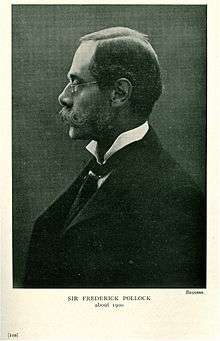Sir Frederick Pollock, 3rd Baronet
| Frederick Pollock | |
|---|---|
 Sir Frederick Pollock (1845–1937)[1] | |
| Born | 10 December 1845 |
| Died | 18 January 1937 (aged 91) |
| Occupation | British academic |
Sir Frederick Pollock, 3rd Baronet PC (10 December 1845 – 18 January 1937)[2] was an English jurist best known for his History of English Law before the Time of Edward I, written with F.W. Maitland, and his lifelong correspondence with US Supreme Court Justice Oliver Wendell Holmes. He was a Cambridge Apostle.
Life
Frederick Pollock was the eldest son of William Frederick Pollock, Master of the Court of Exchequer, and Juliet Creed, daughter of the Rev, Harry Creed. He was the grandson of Sir Frederick Pollock, 1st Baronet, Lord Chief Baron of the Exchequer, the great-nephew of Field Marshal Sir George Pollock, 1st Baronet, and the first cousin of Ernest Pollock, 1st Viscount Hanworth, Master of the Rolls.
He was educated at Eton College, where he was a King's Scholar, and Trinity College, Cambridge, where he was elected Fellow in 1868 (later Honorable Fellow in 1920).[3][4] In 1871 he was admitted to the Bar. He wrote a series of text books that took a new approach to the teaching of English Law including The Principles of Contract at Law and in Equity (1876) and The Law of Torts (1887).[2] Rather than relying on specific applications of law these works emphasised underlying principles. They acted as models for future textbooks and helped modernise English legal education. Pollock taught at the University of Oxford (1883–1903),[2] as Corpus Professor of Jurisprudence. He was Professor of Common Law in the Inns of Court (1884–1890).[4] He was Editor of the Law Reports from 1895 to 1935. He was the first editor of the Law Quarterly Review which was founded in 1885.[2] He was also, in 1894, the Chairman of The Society of Authors[5] He was admitted to the Privy Council in 1911.[6] He was elected Treasurer of Lincoln’s Inn in 1931.[4] On 13 Aug 1873 he married Georgina Harriet Deffell (died on 30 March 1935), a daughter of John Deffell.[7] Their first child, daughter Alice Isabella was born on 15 Jun 1876. Pollock’s son, Frederick John Pollock (1878–1963), a noted historian, succeeded to the baronetcy.[8]
Fencing
Together with his younger brother Walter Herries Pollock, he participated in the first English revival of historical fencing, originated by Alfred Hutton and his colleagues Egerton Castle, Captain Carl Thimm, Colonel Cyril Matthey, Captain Percy Rolt, Captain Ernest George Stenson Cooke, Captain Frank Herbert Whittow.[9]
Works
- The Principles of Contract (1876)
- The Law of Torts (1887)
- Leading Cases Done into English (1876)
- Spinoza, His Life and Philosophy (1880)
- History of English Law before the Time of Edward I (1895, with Frederic William Maitland)
- A First Book of Jurisprudence For Students of the Common Law (1896)
- Encyclopædia of the Laws of England with forms and precedents (1907, with Sir Alexander Wood Renton & Maxwell Anderson Robertson)
- For My Grandson (1933)
See also
References
- ↑ From his book For My Grandson (1933)
- 1 2 3 4 Fifoot, C. H. S. (1976). "Pollock, Sir Frederick". In William D. Halsey. Collier's Encyclopedia. 19. New York: Macmillan Educational Corporation. p. 218.
- ↑ "Pollock, Frederick (PLK863F)". A Cambridge Alumni Database. University of Cambridge.
- 1 2 3 For My Grandson (1933) John Murray, Note B: Personal Dates
- ↑ The Times 1 June 1894
- ↑ The London Gazette: no. 28511. p. 5025. 7 July 1911. Retrieved 6 June 2016.
- ↑ "- Person Page 55171". thepeerage.com. Retrieved 2014-09-20.
- ↑ "Sir Frederick Pollock, 3rd Baronet (British scholar) -- Encyclopedia Britannica". britannica.com. Retrieved 2014-09-20.
- ↑ Thimm, Carl Albert. A Complete Bibliography of Fencing and Duelling, London, 1896 Preface
External links
 Works written by or about Frederick Pollock at Wikisource
Works written by or about Frederick Pollock at Wikisource- Pollock, Frederick; Maitland, Frederic William (1899). "The History of English Law Before the Time of Edward I". I (2nd ed.). Cambridge: University Press. Retrieved 2008-06-07.
- Works by Sir Frederick Pollock: at Online Library of Liberty
| Baronetage of the United Kingdom | ||
|---|---|---|
| Preceded by William Frederick Pollock |
Baronet (of Hatton) |
Succeeded by Sir Frederick John Pollock |